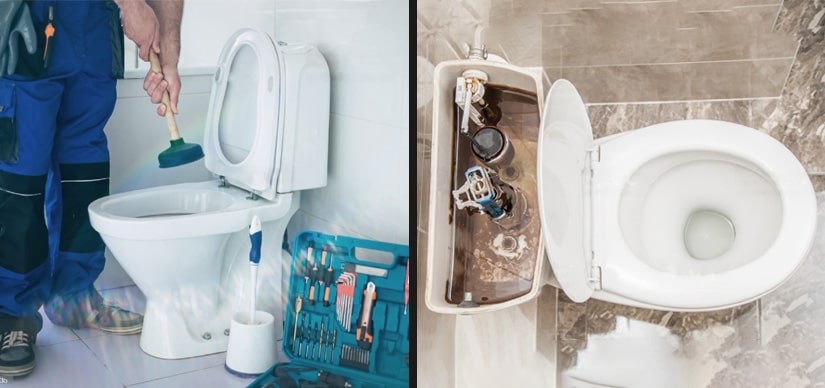Everything should be just as reliable as a toilet. It’s common for one to last longer than 10 to 15 years with little care. But sometimes water leaks from under the bathroom and onto the floor, causing much damage. On the other hand, this type of Water Leak Repair in Orange County is easy, even if this is your first time doing a plumbing repair.
Why is there a leak at the base of the toilet?
Most of the time, the toilet leaks because the seal under it has broken. Below are instructions on installing a new flexible water supply tube and a new wax gasket between the bathroom and the closet flange to make a watertight seal.
If water pools at the bottom of the toilet, it means that the wax seal has broken. Sometimes, though, the problem is somewhere else. You can soak up the water on the floor with a sponge and dry the toilet with a towel. Wait until a new puddle forms on the floor, and then make sure the water comes from underneath the bathroom, not from a loose supply tube, broken shutoff valve, cracked tank, or sweaty bowl.
How do you make it better?
Suppose water is leaking from under the toilet. In that case, you can stop it by tightening the closet bolts in the bathroom, or you can hire a plumber in Orange County for Water Leak Repair in some cases. Use a putty knife or a screwdriver with a slot to pry off the bolts’ covers. Then, using a wrench, tighten each bolt a little at a time. If you use too much force, you could break the toilet’s base.
If you’re lucky, the leak should stop. If tightening the bolts doesn’t fix the problem, you’ll have to take the toilet apart and replace the wax gasket.
A toilet that leaks can be fixed in one of two ways. Keep reading to find out how each method works in detail:
Removing the Toilet
- The first step in replacing a toilet’s wax gasket is to turn off the water at the shutoff valve behind the bathroom or in the basement or crawlspace right below it. Turn the handle all the way around in a clockwise direction.
- Take off the tank’s lid, flush the toilet, and push down on the handle to drain as much water as possible from the tank. Use a sponge to soak up any water left in the tank and a small paper cup to soak up any water left in the bowl.
- Turn the compression nut on the shutoff valve anticlockwise to turn off the water supply.
- Take off the caps on the closet bolts, and then use a wrench to take off the nuts. If one of the bolts spins when the nut is turned, use needle nose pliers to grab the top of the bolt.
- To break the wax seal, grab the edge of the bowl right below where the seat hinges and rock the toilet back and forth. Put a piece of cardboard or a blanket under the bathroom to lift it off the ground. Remove the old wax seal from the bottom of the toilet and the closet flange on the floor with a thin putty knife.
- Check the flange’s condition to ensure it isn’t broken or misshapen. Once we got the wax off, we saw that a big piece of the flange had broken off. If this happens, you can replace the whole flange, put in a new flange, or use a repair strap to replace the missing piece. We chose the option that was both easy and cheap.
- Loosen the two screws that hold the flange to the floor before installing the curved metal strap. Put a new closet bolt on the belt slot, then slide the strap under the flange. To keep the strap in place, tighten the flange screws. Put the last bolt in the closet into the flange. If the bolts don’t stand up straight, wrap a small amount of old gasket wax around the bottom of each one. Put a new wax gasket on the closet flange and ensure it is right in the middle. Most wax gaskets are made of a solid ring of wax. This one is made of soft urethane foam in the middle and resin on the outside. It easily fits the flange and toilet to make a good seal.
Replacing the Toilet:
If the toilet has an old chrome-plated copper supply tube, replace it with a new flexible one made of stainless steel-enmeshed polymer. It makes installation much more accessible and is almost impossible to break.
- Put a thin layer of pipe-joint compound on each end of the supply tube’s fitting, and then tighten one end onto the fill-valve shank that sticks out of the bottom of the toilet tank.
- You are now ready to put the toilet back in place. Grab the toilet bowl near where the seat hinges, lift it and move it to the flange. Place the bathroom on the wax gasket using the closet bolts as guides. Put the washers on top of the bolts, then screw the nuts. But before you tighten them, you have to put all your weight on the edge of the bowl and press down to compress the gasket.
- Make sure the toilet tank is level with the back wall. Tighten each bolt on the closet door one at a time until they are both snugs. Then, press down on the bowl to make the nuts even tighter. Keep doing this until pressing down on the toilet no longer makes the nuts feel like they could fall out.
- Don’t use too much force with the wrench, or you will break the toilet. With a hacksaw, cut the closet bolts, so they are almost flush with the nuts. Then, snap on the bolt caps.
- The last step is to tighten the tube that brings water to the valve that turns off the water.
- Open the valve on the toilet and flush it more than once. If the bowl leaks, press down on it and slightly tighten the nuts. If the toilet isn’t leaking, use it for two weeks, then take off the bolt caps and tighten the nuts again. After a few uses, the bathroom will often settle.
Caulking Process:
There has been a dilemma about whether or not you should caulk around the base of the toilet. Most companies for Water Leak Repair in Orange County don’t do this because they fear the caulk will hide any leaks. In some cities, though, the local building code says that you must caulk around the toilet to stop bacteria from growing there. Check with your city’s building department to determine the rules. If you choose to caulk, use a high-quality, mildew-resistant tub-and-tile caulk.



